 |
July 2, 2008 in our state by state U.S. unemployment forecast Housing Bubble Correction Update: Fasten your seat belts, here comes the jobs crash we said, “The rate of growth in unemployment in some states may shock you...” In November 2008 we published our industry sector analysis of future unemployment Unemployment by industry: Brace for Impact that concluded, “In total we see the US economy losing between seven and 13 million jobs by the end of 2009 representing a 5% to 10% increase in unemployment.” Investors who got sucked into the early year rally (see Beware Relief Rallies Update 1: DJIA 7552 the Debt Deflation Bear Market bottom?) took a beating today when the two "surprising" unemployment reports shocked the market, producing a 245 point drop in the DJIA on the news. This story was typical.
NEW YORK (Reuters) - Job losses and plans to lay off workers hammered the struggling U.S. economy in the final month of 2008, according to private reports that could foreshadow surprisingly grim labor market data from the government on Friday.
U.S. private employers shed 693,000 jobs in December, up sharply from the revised 476,000 jobs lost in November and far more than economists estimated, a report by ADP Employer Services said on Wednesday.
"This is shockingly awful," said Ian Shepherdson, chief U.S. economist at High Frequency Economics in Valhalla, New York. - Private job losses mount, ominous for payrolls, Burton Frierson, Reuters, January 7, 2009
If job losses continue this year at the December 2008 rate reported today the U.S. may see eight million jobs lost in 2009, near the lower end of our seven to 13 million forecast. From that perspective, today's data could be taken as encouraging, except that a review of our per-industry and per-state forecasts from last year indicate troubling signs that lead us to conclude that the monthly rate of job losses will accelerate rapidly early this year, led by retail trade sub-sector of the services sector that was hammered by weak consumer demand during the usually busy holiday shopping season, and piled onto by the now staggering energy and agriculture sectors that were previously supported by a weak dollar that surged toward the end of 2008, cutting foreign demand for U.S. exports.U.S. private employers shed 693,000 jobs in December, up sharply from the revised 476,000 jobs lost in November and far more than economists estimated, a report by ADP Employer Services said on Wednesday.
"This is shockingly awful," said Ian Shepherdson, chief U.S. economist at High Frequency Economics in Valhalla, New York. - Private job losses mount, ominous for payrolls, Burton Frierson, Reuters, January 7, 2009
Four states are representative of our unemployment growth thesis: Housing Bubble Ground Zero states Florida and California, FIRE Economy employment dependent New York state, and the Energy and Food Inflation state of Idaho. Idaho is among a few states that we called out as potential bright spots in our otherwise gloomy per-state unemployment forecast. The surging dollar forces us to revoke even that small glimmer of promise in the post FIRE Economy collapse.
Forecast July 2008
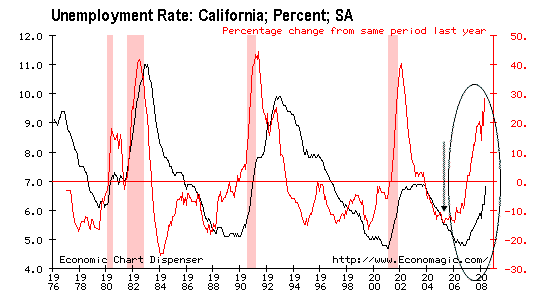
Ground Zero state
National Unemployment Growth Rank: 4
Macro-economic Vulnerability: High
Unemployment Growth Rate: High
Estimated Post Recession Peak Unemployment Rate: 10%
Future Home Values Rating: Poor
Actual January 2009
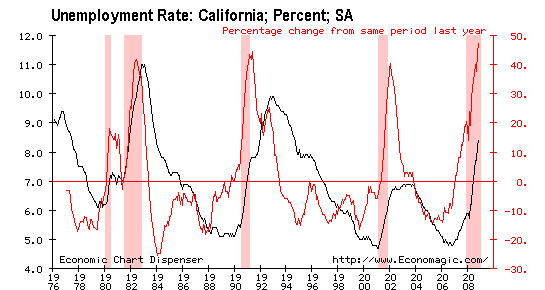
Reassessment: With unemployment already pushing 8.5% from 6.5% at the time of our previous forecast, we are revising our forecast for CA unemployment to peak at 12% versus 10%.
Forecast July 2008
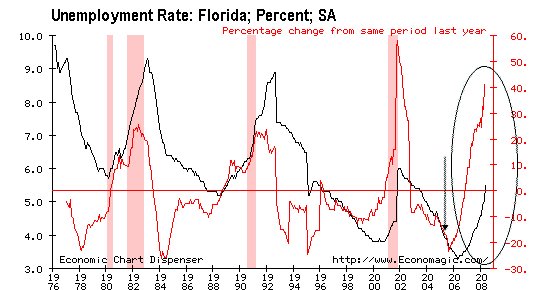
Ground Zero state
National Unemployment Growth Rank: 2
Macro-economic Vulnerability: High
Unemployment Growth Rate: High
Estimated Post Recession Peak Unemployment Rate: 10%
Future Home Values Rating: Poor
Actual January 2009
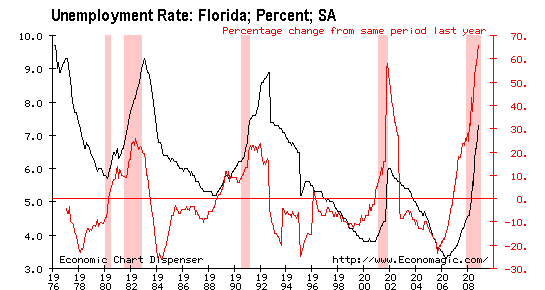
Reassessment: With unemployment close to 7% from 5.5% at the time of our previous forecast, we are holding to our forecast for FL unemployment to peak at 10%.
Forecast July 2008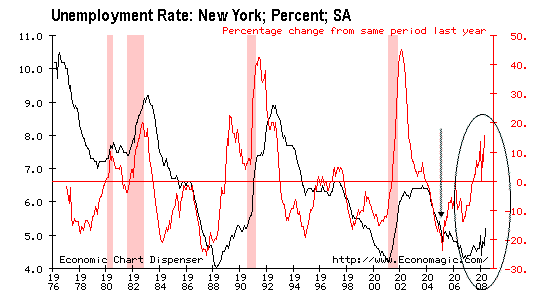
Ground Zero state
National Unemployment Growth Rank: 33
Macro-economic Vulnerability: High
Unemployment Growth Rate: High
Estimated Post Recession Peak Unemployment Rate: 8%
Future Home Values Rating: Poor
Actual January 2009
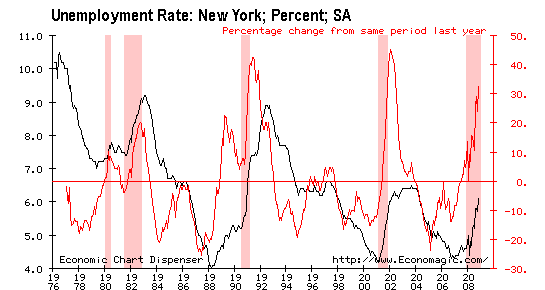
Reassessment: With unemployment above 6% from 5% at the time of our previous forecast, we are raising our forecast for NY unemployment to peak at 10% versus 8%.
Forecast July 2008
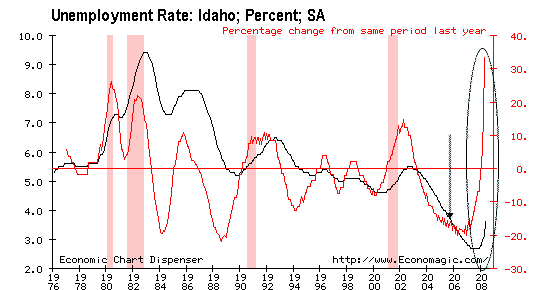
Energy and Food Inflation State
National Unemployment Growth Rank: 9
Macro-economic Vulnerability: Moderate
Unemployment Growth Rate: Moderate
Estimated Post Recession Peak Unemployment Rate: 7%
Future Home Values Rating: Fair
Actual January 2009
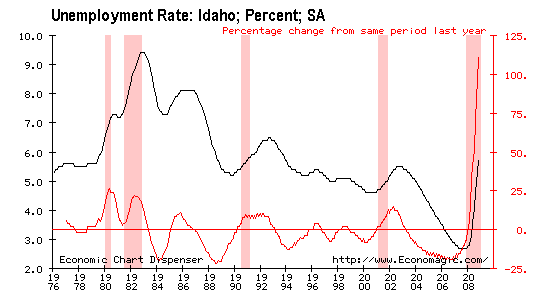
Reassessment: With unemployment rising very rapidly from 3.5% from 6.5% at the time of our previous forecast, we are revising our forecast for ID unemployment to peak at 10% versus 7%.
In addition to the state by state upward revisions to our unemployment forecast, the national picture shows that we are in early innings of the job loss process. Unemployment is a lagging indicator that has since the start of the FIRE Economy era in the early 1980s tended to continue to rise for six months or so after a recession ends. We attribute this to a combination of changes in unemployment reporting as well as the dynamics of monetary policy in the asset price inflation based growth FIRE Economy; business expansion that increases labor demand is a secondary effect of asset price inflation. In the post FIRE Economy era, we expect to see unemployment rates exceed 1980s recession rates, and coincident with the contraction rather than lagging. The rate of growth in unemployment is not likely to slow until stimulus takes effect in 2010.
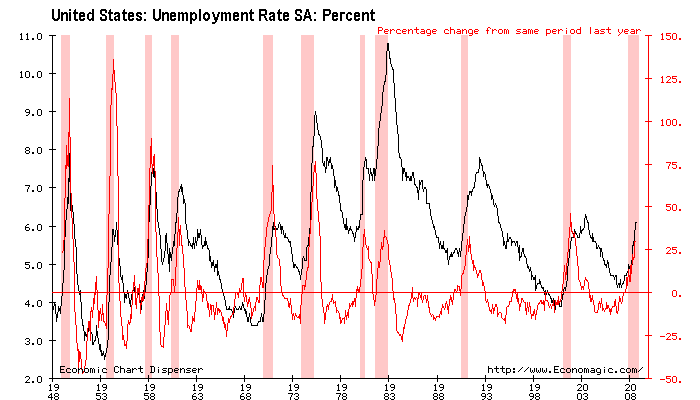
Unfortunately, as dreadful as today's employment data are, readers should expect to see unemployment rising in every sector and state of the U.S. economy and see job losses increase to a rates as high as 1 million per month this year. Fortunately, as an iTulip reader you are financially prepared. If you are new here then at least you will be psychologically prepared. Here is our best estimate of where we think out favorite leading unemployment indicator, median duration of unemployment, will be mid year. We will return to this chart for comparison to forecast later this year.
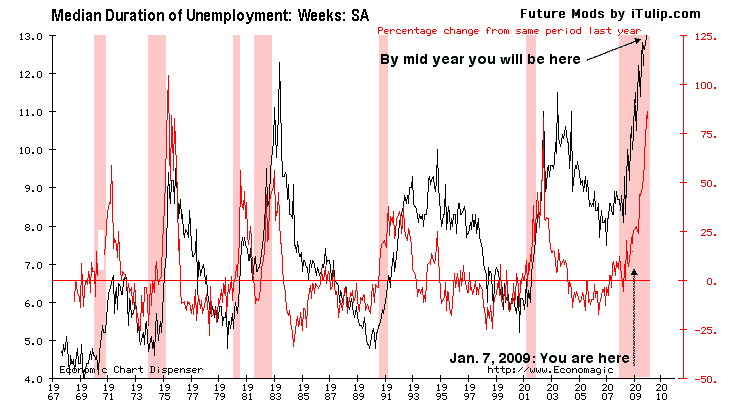
Projected rise in Median Duration of Unemployment by June 2009: 13 weeks from 10.5 weeks currently
Eventually we'll work out way out of this mess, of course. Small private companies not big public companies will, as always, pull the U.S. economy out of recession. Tax cuts targeted at the private business sector of the US economy are urgently needed. Fiscal stimulus must aim to provide a return on investment not merely create jobs, otherwise the nation will be left with more debt but with no greater capacity to pay it.
iTulip Select: The Investment Thesis for the Next Cycle™
__________________________________________________
To receive the iTulip Newsletter or iTulip Alerts, Join our FREE Email Mailing List
Copyright © iTulip, Inc. 1998 - 2009 All Rights Reserved
All information provided "as is" for informational purposes only, not intended for trading purposes or advice. Nothing appearing on this website should be considered a recommendation to buy or to sell any security or related financial instrument. iTulip, Inc. is not liable for any informational errors, incompleteness, or delays, or for any actions taken in reliance on information contained herein. Full Disclaimer

Comment